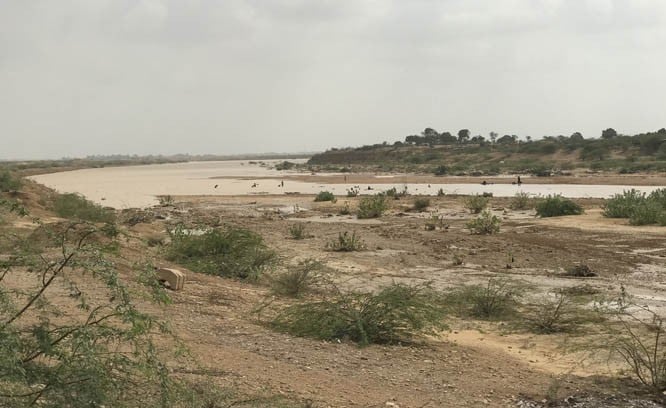
While the rest of Karachi comes to a standstill during heavy rains, it is good news for farms in Malir

The sun has come up, painting the sky pink. Cattle graze against the backdrop of River Malir or relax under tall wild bushes. Ducks roam about in the slough. Sparkling dew continues to dampen the soil.
The flora and fauna appear to have been given a new life. It seems like it has been a week since flood water flowed under the Link Road Bridge, which connects Super and National Highways, a few kilometres from Kathore. A few women draped in colorful Sindhi attire wash clothes and utensils at a pond formed at the river bank.
The river is seasonal. It enters Karachi from the north east and drains into the Arabian Sea. Its catchment areas in the Kirthar mountain range in Balochistan and Sindh.
While life in the rest of the city came to a standstill following two spells of heavy rain, there are some in Malir district who look to these flash floods as relief. This scribe visited several areas on the river bank after the recent spell of rain accompanied by Tofiq Pasha, a horticulturist who has been living along the river most of his life.
Karachi’s Malir district is famous for its fruits and vegetable farms. The sinking groundwater level has turned these farmlands into residential areas over the years. "Malir’s soil is similar to that of Thar’s," says Pasha.
Pasha is happy to see heavy rainfall after years of dry spell, so is Sadiq Baloch, a farmer for 35 years. Farmers who had stopped growing fields in Malir, might come back. "Yeh naddi teen ya chaar saal baad aati hai (the water in the river flows every three to four years)," says Baloch.
Old times
Standing at the bank of a weir near Memon Goth, Pasha recalls there weren’t any weirs in Malir when he was young. The river used to be heavily flooded, he recalls. Pointing towards farms and bridges far from the weir, he says the area used to be under water.
According to Baloch, the area from Ibrahim Haideri to Mol in Gadap Town would remain green throughout for a long time after rainfalls during the British era. "It was the most beautiful part of the city," he adds.
Sindh Abadgar Board’s senior vice president, Syed Mehmood Nawaz Shah says the district was named Malir because in Sindhi it means greenery. "It was a green valley," he says.
On a visit to the river, a visitor who is also a resident of Malir, offers a guava to Pasha which he has brought from his orchard. "Malir was once famous for its guava and green chili," he says, lamenting that commercialisation and illegal excavation from the riverbed have cost them their farms. Nobody seems to know how many farmers are there in the district. Most of them have sold their lands and opted for other businesses.
Illegal excavation
Pasha, Baloch and Shah blame excavation in the river-bed. "Excavation took place at a very large scale in the past. Huge amounts of gravel have been taken out from the river," Pasha points out.
He says floodwater makes its way from mountainous regions all the way to the river and the gravel flows with it. "The government has now constructed weirs on these rivers. These weirs store some of the water and allow the rest to flow. The floodwater charges the aquifer through the gravel and provides wells in surrounding areas with fresh water."
Sometimes gravel in the river takes months to absorb water. "With such rains, when the river is in flood, we [irrigators] benefit the most," he says, adding that due to dry spells in the city, not only had the river gone dry but seawater had started seeping into the groundwater.
More rains?
Both Pasha and Baloch look forward to the next spell of rain. "Rain is always welcome for Malir’s soil," Pasha says, adding, "With heavy rains, water level in their wells rises."
After the first spell of rain, farmers begin to hope that the trend continues and shall benefit crops like maize, tomato, cauliflower, cabbage, green chili and courgette. Fodder for cattle can also be grown. During dry spells, Pasha says, many farmers sell off their cattle as fodder becomes expensive. "When it rains, we have grass everywhere -- it is the natural fodder for cattle."
Weirs on Malir river
Sindh Irrigation Department’s Chief Engineer Syed Sardar Shah says there are three weirs and 10 small dams on the river. Weir One is located near Memon Goth, Weir Two is located near motorway and Weir Three is located near Jokhyo Goth.
The dams on the river are: Mole Dam, Sukhan Dam, Mir Chakar Dam, Jharando Dam, Langheji Dam, Thado Dam One, Thado Dam Two, Konkar Dam, Malir Bakshan Dam and Watan Wari Dam.
There’s another stream, Lath Nai, coming from the Kirthar Range, which joins Malir River. Shah says a lesser stream is called Nai in Sindhi. Four dams have been built on it: Lath Dam, Gadap Dam, Lyari Dam and Hasan-jo-Kun Dam. All these dams are managed by Sindh Small Dams Organisation (SSDO).
According to Shah, these are not large dams. "They consist of a wall. After water reaches its top, it overflows," he says, adding that the water stored in the dams otherwise recharges wells. It also acts as a speed-breaker for water which can cause destruction in the city."